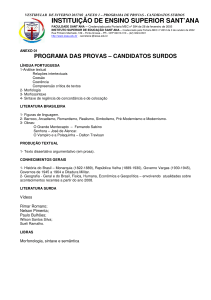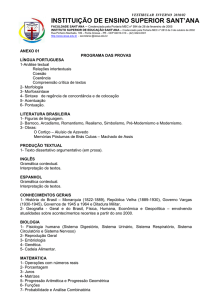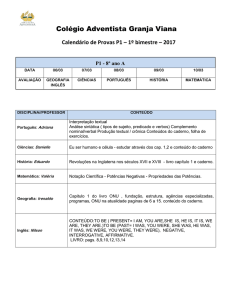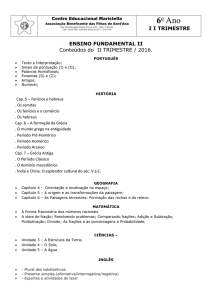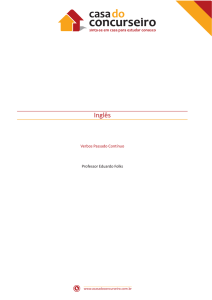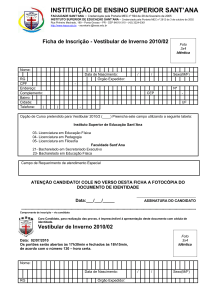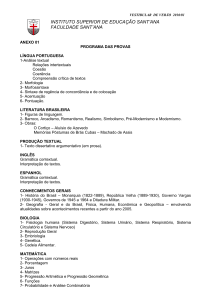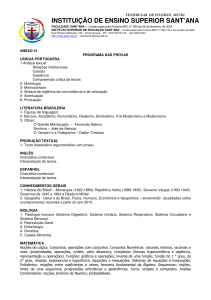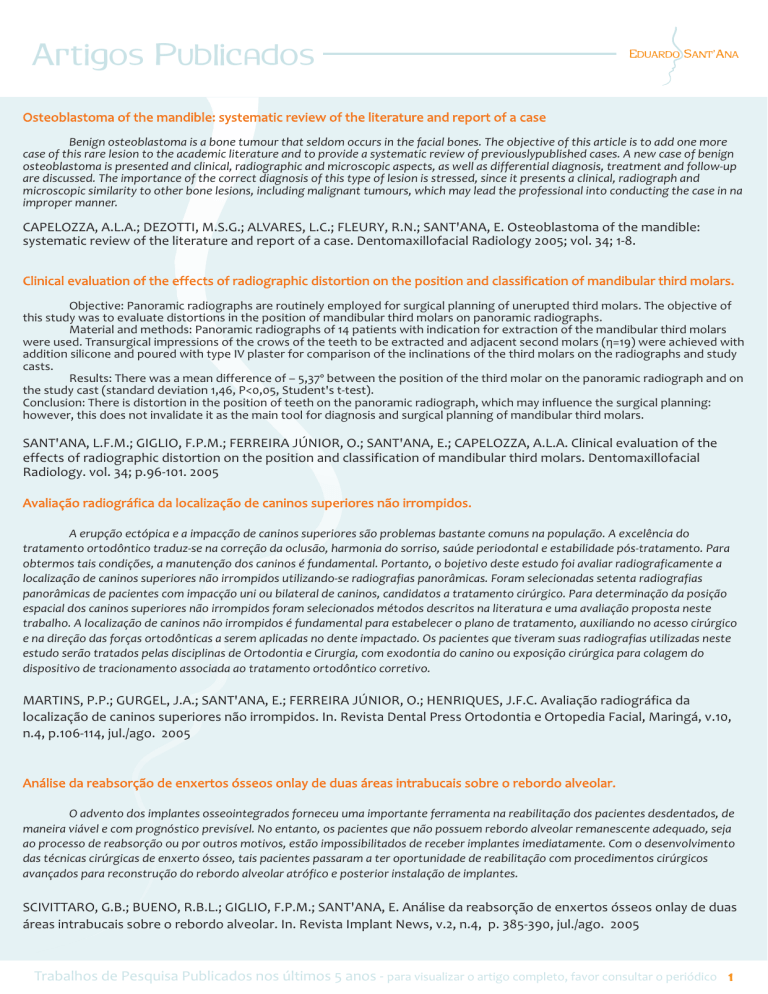
A
r
t
i
g
o
s
P
u
b
l
i
c
a
d
o
s
Osteoblastoma of the mandible: systematic review of the literature and report of a case
Benign osteoblastoma is a bone tumour that seldom occurs in the facial bones. The objective of this article is to add one more
case of this rare lesion to the academic literature and to provide a systematic review of previouslypublished cases. A new case of benign
osteoblastoma is presented and clinical, radiographic and microscopic aspects, as well as differential diagnosis, treatment and follow-up
are discussed. The importance of the correct diagnosis of this type of lesion is stressed, since it presents a clinical, radiograph and
microscopic similarity to other bone lesions, including malignant tumours, which may lead the professional into conducting the case in na
improper manner.
CAPELOZZA, A.L.A.; DEZOTTI, M.S.G.; ALVARES, L.C.; FLEURY, R.N.; SANT'ANA, E. Osteoblastoma of the mandible:
systematic review of the literature and report of a case. Dentomaxillofacial Radiology 2005; vol. 34; 1-8.
Clinical evaluation of the effects of radiographic distortion on the position and classification of mandibular third molars.
Objective: Panoramic radiographs are routinely employed for surgical planning of unerupted third molars. The objective of
this study was to evaluate distortions in the position of mandibular third molars on panoramic radiographs.
Material and methods: Panoramic radiographs of 14 patients with indication for extraction of the mandibular third molars
were used. Transurgical impressions of the crows of the teeth to be extracted and adjacent second molars (ç=19) were achieved with
addition silicone and poured with type IV plaster for comparison of the inclinations of the third molars on the radiographs and study
casts.
Results: There was a mean difference of – 5,37º between the position of the third molar on the panoramic radiograph and on
the study cast (standard deviation 1,46, P<0,05, Student's t-test).
Conclusion: There is distortion in the position of teeth on the panoramic radiograph, which may influence the surgical planning:
however, this does not invalidate it as the main tool for diagnosis and surgical planning of mandibular third molars.
SANT'ANA, L.F.M.; GIGLIO, F.P.M.; FERREIRA JÚNIOR, O.; SANT'ANA, E.; CAPELOZZA, A.L.A. Clinical evaluation of the
effects of radiographic distortion on the position and classification of mandibular third molars. Dentomaxillofacial
Radiology. vol. 34; p.96-101. 2005
Avaliação radiográfica da localização de caninos superiores não irrompidos.
A erupção ectópica e a impacção de caninos superiores são problemas bastante comuns na população. A excelência do
tratamento ortodôntico traduz-se na correção da oclusão, harmonia do sorriso, saúde periodontal e estabilidade pós-tratamento. Para
obtermos tais condições, a manutenção dos caninos é fundamental. Portanto, o bojetivo deste estudo foi avaliar radiograficamente a
localização de caninos superiores não irrompidos utilizando-se radiografias panorâmicas. Foram selecionadas setenta radiografias
panorâmicas de pacientes com impacção uni ou bilateral de caninos, candidatos a tratamento cirúrgico. Para determinação da posição
espacial dos caninos superiores não irrompidos foram selecionados métodos descritos na literatura e uma avaliação proposta neste
trabalho. A localização de caninos não irrompidos é fundamental para estabelecer o plano de tratamento, auxiliando no acesso cirúrgico
e na direção das forças ortodônticas a serem aplicadas no dente impactado. Os pacientes que tiveram suas radiografias utilizadas neste
estudo serão tratados pelas disciplinas de Ortodontia e Cirurgia, com exodontia do canino ou exposição cirúrgica para colagem do
dispositivo de tracionamento associada ao tratamento ortodôntico corretivo.
MARTINS, P.P.; GURGEL, J.A.; SANT'ANA, E.; FERREIRA JÚNIOR, O.; HENRIQUES, J.F.C. Avaliação radiográfica da
localização de caninos superiores não irrompidos. In. Revista Dental Press Ortodontia e Ortopedia Facial, Maringá, v.10,
n.4, p.106-114, jul./ago. 2005
Análise da reabsorção de enxertos ósseos onlay de duas áreas intrabucais sobre o rebordo alveolar.
O advento dos implantes osseointegrados forneceu uma importante ferramenta na reabilitação dos pacientes desdentados, de
maneira viável e com prognóstico previsível. No entanto, os pacientes que não possuem rebordo alveolar remanescente adequado, seja
ao processo de reabsorção ou por outros motivos, estão impossibilitados de receber implantes imediatamente. Com o desenvolvimento
das técnicas cirúrgicas de enxerto ósseo, tais pacientes passaram a ter oportunidade de reabilitação com procedimentos cirúrgicos
avançados para reconstrução do rebordo alveolar atrófico e posterior instalação de implantes.
SCIVITTARO, G.B.; BUENO, R.B.L.; GIGLIO, F.P.M.; SANT'ANA, E. Análise da reabsorção de enxertos ósseos onlay de duas
áreas intrabucais sobre o rebordo alveolar. In. Revista Implant News, v.2, n.4, p. 385-390, jul./ago. 2005
Trabalhos de Pesquisa Publicados nos últimos 5 anos - para visualizar o artigo completo, favor consultar o periódico 1
A
r
t
i
g
o
s
P
u
b
l
i
c
a
d
o
s
Queratocisto Odontogênico e múltiplos dentes supranumerários associados à síndrome de ehlers-danlos –Relato de um
caso clínico
The Ehlers-Danlos Syndrome is a hereditary disturbance of the connective tissue related to collagen's metabolism.
Deficiency or alteration of the collagem present in the tissues results in some classical signs, such as: Skin hyperelasticity,
articicular hypermobility and vascular fragility, among others. There are, also, the EDS oral manifestations little cited in the
literature. The clinical case refers to a 15-year old female patient, who was referred to FOB-USP after her dentist requested a
panoramic radiograph and verified the presence of a cyst between teeth 44 and 45 and the presence of 6 supranumerary
teeth. Upon general clinic exam, the presence of articular hypermobility, mild skin hyperelasticity was verified, and in
anamnesis, a history of body ecchymosis, deriving from mild traumas. The association of these signs led us to the hypothesis
that, possibly, the signs would be part of the Ehlers-Danlos Syndrome. The patient was evaluated at the HRAC's genetic
section, being an EDS mild type II or III confirmed. The oral manifestations found in this case have scarcely been mentioned in
the literature, being their association unique. We further highlight the importance of EDS diagnosis in patients who need
treatment and the due care for their assistence.
ALMONTE, M.E.R.; CARDOSO, C.L.;FERREIRA JÚNIOR, O.; CAPELOZZA, A.L.A.; OLIVEIRA, M.Z.; SANT'ANA, E.
Queratocisto Odontogênico e múltiplos dentes supranumerários associados à síndrome de ehlers-danlos –Relato de um
caso clínico. Brazillian Journal of Oral Sciences (Anais da III International Dental Meeting – UNICAMP and XII Dental
Meeting of Piracicaba). v.4 n.14, jul/september 2005. p.855
O uso de marcadores para identificação de posicionamento dentário em telerradiografias frontais póstero-anteriores:
propósta de um método.
Objetivos: avaliar a confiabiliddade na identificação de marcadores observados em radiografias PA. Metodologia: em 3 crânios
humanos secos procedeu-se à instalação de aparelhos expansores do tipo Hyrax, nos quais adaptam-se marcadores nos acessórios
ortodônticos. Resultados: a comparação estatística dos 27 cefalogramas confeccionados revelou para as medidas angularesvalores dos
erros com pequenas variações, entretanto os menores erros foram encontrados para as medidas lineares entre os marcadores. Deste
modo, conclui-se que a pouca variabilidade na identificação dos marcadores demonstrou sua confiabilidade para o uso em estudo com
teleradiografias PA.. Os erros para as médias angulares atribui-se às dificuldades na determinação de estruturas anatômicas. Conclusão:
os marcadores avaliados neste estudo parecem prestarem-se como estruturas confiáveis em telerradiografias PA utilizadas em pesquisas
longitudinais.
GURGEL, J.A., SANT'ANA, E., FERREIRA JR., O., SANT'ANA, L. F. M., GIGLIO, F.P. M. O uso de marcadores para
identificação de posicionamento dentário em teleradiografias frontais óstero-anteriores: propósta de um método.
Revista Dental Press de Ortodontia e Ortopedia Facial, v. 10 – N. 6 – Novembro / Dezembro – 2005, Maringá - PR, nov. /
dez. – 2005, p. 84 - 90
Odontogenic Myxoma – A case report and clinico-radiographic study if seven tumors
The primary aim of this paper is to present clinical and radiographic aspects of odontogenic myomas diagnosed at the
Stomatology Clinic of Bauru School of Dentistry, University of São Paulo, Brazil, and to compare them withdata reported in a series
published in the literature. A second objective is kto report a clinical case of odontogenic myoma in a 9-year-old patient in whom the
lesion involved the anterior region of the maxilla. Dental records between 1975 and 2000 were reviewed and seven cases diagnosed as
odontogenic myoma were found in individuals aged from nine to 60 years. Of these, four ocurred in women and three men. The
mandible was affected in five cases and the maxilla in two. All patients presented with asymptomatic swelling in the affected area. A
mixed radiographic result was observed in five patients, while in two patients the lesion was completely radiolucent. The borders of the
lesion were well-defined in six patients. In four cases there was dental displacement, although root resorption was not observed in any of
these. The treatment of choice was surgical excision. Four cases did not recur during the period of follow-up, which varied from nine
months to 19 years. It was concluded the clinico-radiographic study of dodontogenic myxomas should be continually refined with the aim
of offering the patient an appropriate treatment, since the lesion presents a high potential for recurrence.
DEZOTTI, M. S. G.; AZEVEDO, L. R.; FONTÃO, F. N. G. K.; CAPELOZZA, A. L. A.; SANT'ANA, E. Odontogenic Myxoma– A
case report and clinico-radiographic study if seven tumors, The Journal of Contemporary Dental Practice, vol. 7, n. 1,
Februrary 15, 2006
Trabalhos de Pesquisa Publicados nos últimos 5 anos - para visualizar o artigo completo, favor consultar o periódico 2
A
r
t
i
g
o
s
P
u
b
l
i
c
a
d
o
s
Chronic sinusitis unresponsive to medical therapy: a case of maxillary sinus actinomycosis focusing on computed
tomography findings
Actinomycosis of the paranasal sinuses is a rare occurrence and it's clinical presentation does not suggest a specific diagnosis.
Therefore, actinomycosis should be included in the differential diagnosis of neoplasms and granulomatous lesions of the head and neck
region. However, the differentiation from a malignant neoplasm is not easy because the radiological findings are frequently similar and
positive cultures are difficult to obtain. This report highlights the clinical progress of paranasal actinomycosis associated with some
computed tomography findings that can be extremely helpful in the correct diagnosis. The characteristics of the disease are described
and the relevant leterature is discussed.
DAMANTE, J. H; SANT'ANA, E.; SOARES, C. T.; MOREIRA, C. R. Chronic sinusitis unresponsive to medical therapy: a case
of maxillary sinus actinomycosis focusing on computed tomography findings, Dentomaxillofacial Radiology, 2006, 35, p.
213-216
Planejamento digital em cirurgia ortognática: precisão, previsibilidade e praticidade
A cirurgia ortognática deixou de ser um procedimento com finalidade exclusivamente funcional e a estética facial consagrou-se
como um dos objetivos mas importantes da Cirurgia e da Ortodontia. A evolução dos conceitos envolvidos no diagnóstico e plano de
tratamento em Cirurgia Ortognática tem sido imensurável. As metas para o tratamento dos pacientes tornaram-se mais amplas, levando
ao desenvolvimento de novos instrumentos de diagnóstico. Dentre eles, destaca-se o planejamento cirúrgico digital, o qual proporciona
maior previsibilidade e padronização de toda seqüência clínica, além de ser um método extremamente preciso. Considerando a análise
clínica soberana e imprescindível ao planejamento de sucesso, a proposição neste artigo foi evidenciar pontos importantes na análise
clínica e na predicção digital, e apresentar um caso clínico, cujo tratamento foi executado seguindo as linhas mais modernas em termos
de análise facial e planejamento cirúrgico digital.
SANT'ANA, E.; FURQUIM, L. Z.; RODRIQUES, M.T. V.; KURIKI, E. U.; PAVAN, A. J.; CAMARINI, E. T.; IWAKI FILHO, L.
Planejamento digital em cirurgia ortognática: precisão, previsibilidade e praticidade, Revista Clin. Ortodon. Dental Press,
Maringá, v.5, nº 2, abril/maio 2006, p. 92-102
Síndrome da apnéia obstrutiva do sono (SAOS) – O papel da cirurgia ortognática no aumento das vias aéreas superiores
Os tratamentos conservadores para a Síndrome da Apnéia Obstrutiva do Sono (SAOS), em especial o aparelho nasal
“continuous positive airway pressure” (CPAP), constituem uma rotina no tratamento de pacientes com apnéia. Mas de acordo com os
objetivos e parâmetros que guiam a cirurgia para o tratamento da SAOS, o avanço maxilomandibular (AMM) não deve ser restrito aos
casos mais severos, utilizado somente como último recurso após falha de procedimentos prévios. Deve ser também indicado como
primeira escolha nos casos de estreitamento da orofaringe e/ou hipofaringe. O manejo de pacientes com SAOS requer uma equipe
multidisciplinar, incluindo o cirurgião-dentista e o médico do sono, para que seja conduzido um minucioso diagnóstico e como
conseqüência correto tratamento da doença. A SAOS é uma doença sistêmica potencialmente fatal com freqüência associada com
hipertensão, hipertensão pulmonar, arritmias cardíacas noturnas, infarto do miocárdio, que em grande parte dos pacientes não é
diagnosticada. Este trabalho tem por objetivos fornecer ferramentas de diagnósticos aos cirurgiões-dentistas, apresentar a opinião de
vários autores sobre as modalidades de tratamento de pacientes com SAOS, suas indicações, contra-indicações, vantagens e
desvantagens. E também apresentar um caso clínico que além do avanço mandibular, utilizou-se uma técnica de avanço do tubérculo
Geni para aumento dos espaços das vias aéreas superiores.
SANT'ANA, E.; FERREIRA JR., O.; MOURA NETO, G.; FERREIRA, G. R.; RODRIGUES, M. T. V. Síndrome da apnéia obstrutiva
do sono (SAOS) – O papel da cirurgia ortognática no aumento das vias aéreas superiores. Ortodontia SPO,
Jan./Mar.2006, v.39, nº1, p. 56-63
Estudo comparativo de dois modelos de campos cirúrgicos utilizados em cirurgia bucal ambulatorial.
Objetivo: Avaliar qual campo cirúrgico utilizado em cirurgia bucal sob anestesia local oferece maior conforto ao paciente sem
comprometer os preincipios básicos de biossegurança.
Métodos: Ttinta e três pacients foram submetidos à exodontia de seus terceiros molares não irrompidos, em duas sessões, num total de
66 cirurgias. Foram selecionados dois modelos de campos cirúrgicos fenestrados, um expondo toda a face do paciente e outro expondo
somente a boca ao cirurgião. Após a realização das duas cirurgias (uma para cada modelo de campo), foi aplicado um questionário
objetivo aos pacientes, que elegiam o modelo de campo que lhes oferecerá maior conforto.
Resultados: No final, 87,87% dos pacientes escolheram o campo no qual a face ficava toda exposta, enquanto 9,09% escolheram o campo
que expõe toda a face oferece maior conforto transoperatório ao paciente.
GURGEL, C.N.C.; GIGLIO, F.P.M.; SANT'ANA, L.F.M.; FERREIRA JÚNIOR, O.; SANT'ANA, E. Estudo comparativo de dois
modelos de campos cirúrgicos utilizados em cirurgia bucal ambulatorial.Revista Ciências Médicas, Campinas, V.15, n.3,
p.205-210, maio/junho, 2006.
Trabalhos de Pesquisa Publicados nos últimos 5 anos - para visualizar o artigo completo, favor consultar o periódico 3
A
r
t
i
g
o
s
P
u
b
l
i
c
a
d
o
s
Ancoragem esquelética com miniimplantes: incorporação rotineira da técnica na prática ortodôntica.
A Ortodontia baseia-se no diagnóstico bucal e facial para elaborar o plano de tratamento e na mecânica para conduzir ao
resultado esperado. Uma das limitações do tratamento pode ser a deficiência de ancoragem pela ausência de dentes de suporte, pela
dificuldade da movimentação, pela limitação da técinica empregada ou pela falta de colaboração do paciente em utilizar aparelhos
removíveis e elásticos. Os miniimplantes surgiram como uma alternativa viável para resolver estes problemas e podem ser empregados
de forma rotineira na clínica ortodôntica, pela facilidade de instalação e remoção, conforto ao paciente e baixo custo. As possibilidades
de uso são inúmeras e o planejamento da posição em que serão instalados é importante para se obter os vetores de força desejados.
Neste artigo as indicações, contra-indicações e intercorrências são discutidos e um caso clínico apresentado.
JANSON,M.; SANT'ANA, E.; VASCONCELOS, W. Ancoragem esquelética com miniimplantes: incorporação rotineira da
técnica na prática ortodôntica. Revista Clínica de Ortodontia, Dental Press, Maringá, V.5, nº 4, p.85-100, agosto/setembro
2006.
Spontaneous fracture of genial tubercles: case report.
A case is presented of fractured genial tubercles, revealed by conclusal radiography, in a 63-year-old endetulous woman. Isolated
fractures are a rare event that may present with pain and edema in the floor of the mouth. It occurs mainly in patients wearing a
complete denture when the mandible is atrophied and the genial tubercles are hypertrophied. Only 11 case reports have been found in
the English kiterature. (Quintessence Int 2006;37:737-739)
Yaedú, R.Y.F.; RUBIRA-BULLEN, I.R.F.; SANT'ANA, E. Spontaneous fracture of genial tubercles: case report. Quintessence
International, USA, V.37, nº9, p. 737-739, October 2006.
Importância clínica do diagnóstico de fratura da crista alveolar nos procedimentos de expansão rápida de maxila
assistida cirurgicamente.
A expansão rápida de maxila assistida cirurgicamente (ERMAC) tem sido cada vez mais utilizada no tratamento de pacientes
portadores de deficiências transversais de maxila, após a fase de crescimento. Durante o trans-operatório, podem ocorrer dois tipos de
fraturas na crista óssea alveolar entre os incisivos centrais superiores: a fratura simétrica e a assimétrica. A utilização de um protocolo de
ativação do parafuso expansor, após a cirurgia, sem levar em consideraçãoas particularidades da fratura da crista aleolar pode resultar
em complicações tardias como: mobilidade dentária, criação de defeitos desses permanentes e prejuízo estético do sorriso. Sendo assim,
é importante reconhecer o tipo de fratura, por meio de diagnóstico periapical e oclusal, para estabelecer uma melhor conduta em
relação ao período, tipo ou quantidade de ativaçãopós-operatória do parafuso expansor.
OLIVEIRA, M.Z.; CARDOSO, C.L.; FREITAS, D.S.; SANT'ANA, E.; FERREIRA JÚNIOR, O. Importância clínica do diagnóstico
de fratura da crista alveolar nos procedimentos de expansão rápida de maxila assistida cirurgicamente. Revista clínica de
ortodontia Dental Press, Maringá, V.6, nº 1, p. 85-98, fevereiro/março2007.
Apnoea – hypopnoea and mandibular retrusion as uncommon findings associated with Proteus syndrome.
The actiology of Proteus syndrome (PS) is yet unclear. This disease includes partial gigantism of the hands and/or feet, nevi,
hemihypertrophy due to overgrowth of long bones, subcutaneous tumors, macrocephaly, cranial hyperostosis, and pulmonary and
renal abnormalities. The case report isabout a 17-year-old boy with two uncommon findings associated with PS: apnoea-hypopnoea
and mandibular retrusion. A multidisciplinary team was important to provide professional care for this patient. Dentists and
physicians proposed an adjusted treatment and surgical procedure. This represented the initial care for malocclusion treatment and
also the preparation for orthognatic surgery. The oral maxilofacial surgeon and the otorhinolaryngologist proposed this approach in
an attempt to improve pharynx airflow. The patient has been followed for almost 3 years.
NOGUEIRA, R.L.M., TEIXEIRA, R.C.; LIMA, M.C.; SANT'ANA, E.; SANTOS, C.F. Apnoea – hypopnoea and mandibular
retrusion as uncommon findings associated with Proteus syndrome. Dentomaxillofacial Radiology, Vol. 36, 2007, p. 367371.
Trabalhos de Pesquisa Publicados nos últimos 5 anos - para visualizar o artigo completo, favor consultar o periódico 4
A
r
t
i
g
o
s
P
u
b
l
i
c
a
d
o
s
A bizarre extraoral fístula with intraoral manifestations.
Acute abscéss is a common manifestation and needs urgent care. In it's advanced stage, it may drain spontaneously through a
fístula; it may be extra-oral, depending on the causing tooth, root site, bone thickness and muscle insertions. Spontaneous drainage may
leave significant scars. An extra-oral fistula that communicates with the mouth receives constant recomtamination.
MUNHOZ, E.A.; BULLEN, I.R.F.R.; SANT'ANA, E.; CONSOLARO, A. A bizarre extraoral fistula with intraoral manifestations.
Rev. Bras. Otorrinolaringologia, Vol. 73, nº 6, 2007, p. 849.
Radiographic techniques for medical-dental research with minipigs.
Techniques were developed to obtain standardised intra-oral radiographs in minipigs for use in medical dental research. Twelve
male minipigs (BR-I minipigs) were chosen at random. Two animals each at 3, 5, 7, 9, 12 and 15 months of age were anesthetised and
subjected to radiographic examinations to assess six techiniques. Three intra-oral and three extra-oral techniques, standardised for
humans, were used with variations of the angle of incidence of the x-ray beams, focus-film distance and exposure time. Two film
positioners were developed for the intra-oral technique. Two examiners then chose the radiographs with the least image distortion,
greatest clarity and least superimposition of images. For each technique, the suitable angle of incidence of the X-ray beams, the focusfilm distance and exposure time that produced the highest quality radiographs were standardised.
NAVARRO, R.L.; OLTRAMARI, P.V.P.; HENRIQUES, J.F.C.; CAPELOZZA, A.L.A.; SANT'ANA, E.; GRANJERO, J.M.
Radiographic techniques for medical-dental research with minipigs. The veterinary journal, vol. 174, 2007, p. 165-169.
Cirurgia Piezelétrica ou Piezocirurgia em Odontologia: o sonho de todo cirurgião
O sistema adota um conceito já ampalmente conhecido, o de piezoeletricidade. Ao receber estímulos de pressão ou tensão, os
cristais como o quartzo, por exemplo, são capazes de produzir campos eletromagnéticos de intensidade exatamente iguais aos que
receberam, muitas vezes de forma tão perfeita que são utilizados em relógios e em computadores, inclusive para marcar o tempo. Os
cristais de hidroxipatia apresentam a mesma propriedade piezoelétrica, deformando-se em um campo elétrico. Esta tecnologia já é
empregada na Odontologia, utilizando ondas de ultra-som para a remoção de cálculos dentários, por exemplo. Assim esta nova “serra”
utiliza a capacidade de piezoeletricidade óssea para desagregar os cristais de hidroxiapatita em um determinado plano, “cortando” o
osso por meio de vibrações de utra-som.
CONSOLARO, M.F.M-O; SANT'ANA, E.; MOURA NETO, G.. Cirurgia Piezelétrica ou Piezocirurgia em Odontologia: o sonho
de todo cirurgião. Revista Dental Press de Ortodontia e Ortopedia facial, vol. 12, nº 6, 2007, p. 17-20
Application of stereolithography in mandibular reconstruction following resection of ameloblastoma: case report.
Paciente de 32 anos, sexo feminino, com queixa de aumento de volume no lado direito da face, foi indicada para nossa
instituição. Ao exame clínico, apresentou tumoração no lado direito do corpo mandibular, eritema e crepitação à pulpação da região. TC
revelou lesão multilocular compromentendo o ângulo, ramo e parte do corpo mandibular direito. O exame microscópico da lesão
apresentou diagnóstico de ameloblastoma. O tratamento cirúrgico foi ressecção parcial da mandíbula com margens de segurança e
reconstrução com placa de titânio. Descreve-se o planejamento cirúrgico da reconstrução mandibular, utilizando a estereolitografia no
planejamento.
CARDOSO, C.L.; MUNHOZ, E.A.; RIBEIRO, E.D.; SOUZA NETO, J.B.; SANT'ANA, E.; FERREIRA JÚNIOR, O. Application of
stereolithography in mandibular reconstruction following resection of ameloblastoma: case report. Revista Clínica de
Pesquisa Odontológica, Curitiba, maio/agosto 2008, v.4, nº 2, p. 101-105.
Different impacted teeth in monozygotic twins: discussuon of an unusual case.
Dois gêmeos monozigóticos foram indicados para a Clínica Cirúrgica, ambos para remoção de dentes inclusos. Ao exame clínico,
um dos gêmeos apresentou o segundo pré-molar inferior esquerdo incluso, enquanto que o outro apresentava o canino inferior esquerdo
incluso. A literatura indica que alterações no desenvolvimento dentário podem manifestar-se de duas maneiras no contexto desse tipo
de geminação. A primeira manifestação ocorre quando as características são similares, ainda que em lados opostos; nessa situação, é
chamada “imagem em espelho”. A segunda manifestação é a expressão de certas características idênticas em ambos, chamadas
“duplicatas”. Manifestação desses dois tipos está diretamente relacionada com o período de formação dos gêmeos e consequentemente
corionicidade. Esse caso apresenta um distanciamento significativo dos padrões anteriormente descritos, sugerindo que ações locais
desconhecidas ou fatores ambientais foram responsáveis pela alteração dos padrões de expressão dessa característica.
RODRIGUES, M.T.V.; CARDOSO, C.L.; MUNHOZ, E.A.; YAEDÚ, R.Y.F.; SANT'ANA, E.; FERREIRA JÚNIOR, O. Different
impacted teeth in monozygotic twins: discussuon of an unusual case. Revista Clínica de Pesquisa Odontológica, Curitiba,
maio/agosto 2008, v.4, nº 2, p. 95-100.
Trabalhos de Pesquisa Publicados nos últimos 5 anos - para visualizar o artigo completo, favor consultar o periódico 5
A
r
t
i
g
o
s
P
u
b
l
i
c
a
d
o
s
Segmental lefort I osteotomy for treatment of a Class III malocclusion with temporomandibular disorder.
This article reports the case of a 19-year-old Young man with Class III malocclusion and posterior crossbite with concerns about
temporomandibular disorder (TMD), esthetics and funcional problems. Surgical Orthodontic treatment was carried out by
decompensation of the mandibular incisors and segmentation of the maxila in 4 pieces, which allowed expansion and advancement.
Remission of the signs and symptons ocurred after surgical-orthodontic intervention. The maxillary dental arch presented normal
transverse dimension. Satisfactory static and funcional occlusion and esthetic reults were achieved and remained stable. Three years
after the surgical-orthodontic treatment, no TMD sign or symptom was observed and the occlusal results had not changed. When
vertical or horizontal movements ot the maxilla in the presence of moderate maxillary constriction are necessary, segmental LeFort I
osteotomy can be an important part of treatment planing.
JANSON, M.; JANSON, G.; SANT'ANA, E.; NAKAMURA, A.; FREITAS, M.R. Segmental lefort I osteotomy for treatment of a
Class III malocclusion with temporomandibular disorder. Journal of Aplied Oral Science, vol. 16, nº 4, julho/agosto, 2008,
p. 302-309
Histological and molecular temporomandibular joint analyses after mandibular advancement surgery: study in minipigs.
The objective of this study was to elucidate the changes occurring in the temporomandibular joint after surgical mandible
advancement with different fixation techniques: bicortical screws and miniplates. Eighteen minipigs were equally and randomly divided
into 3 groups: Group I(control), nonoperated animals; Group II, animals submitted to surgical advancement surgery and osteosynthesis
by bicortical screws; and Group III, animals submitted to surgical advancement surgery and osteosynthesis by miniplates. Four months
after the surgeries, the presence of interleukin (IL)-6 and IL-10 in synovial fluid samples in ELISA experiments. TMJs were histologically
prepared. Higher levels of IL-10 (p=0,436) were found for Group II. Descripitive histological analysis was compatible with the ELISA
findings. Rigid fixation evokes more pronounced signs of bone remodeling in the TMJ, whereas malleable fixation promotes a more
intense inflamatory activity. Therefore, rigid fixation seems to transmit a higher impact of postoperative masticatory forces to the TMJ.
NAVARRO, R.L.; OLTRAMARI, P.V.P.; SANT'ANA, E.; HENRIQUES, J.F.C.; TAGA, R.; CESTARI, T.M.; CONTI,P.C.R.;
CUNHA,F.Q.; SANTOS, C.F. Histological and molecular temporomandibular joint analyses after mandibular advancement
surgery: study in minipigs. Oral surg, Oral Med, Oral Pathol, Oral Radiol Endod, vol. 106, setembro, 2008, p. 331-338
Abscesso tardio após exodontia de terceiros molares inferiores: relato de dois casos.
Complicações associadas à exodontia de terceiros molares, embora incomuns, podem ocorrer em alguns casos. As infecções são
tratadas local e sistemicamente e nem sempre se disseminam para os espaços faciais primários e secundários. O presente artigo relata
dois casos com evoluções atípicas após exodontia de terceiro molar de dois pacientes jovens, leucodermas e saudáveis que apresentam
quadro de abscesso três semanas após a cirurgia. No caso 1, foi diagnosticada a presença de um fragmento ósseo expelido,
correspondente à tábua óssea lingual e teve sua drenagem intra-oral. Porém, no caso 2, o abscesso se disseminou envolvendo os espaços
fasciais e foi necessária drenagem por via extra-oral. Além disso, não foi definida a causa específica e algumas hipóteses foram levantadas
e discutidas nesse artigo.
CARDOSO, C.L..; RIBEIRO, E.D.; BERNINI, G.F.; FREITAS, D.S.; FERREIRA JR., O.; SANT'ANA, E. Abscesso tardio após
exodontia de terceiros molares inferiores: relato de dois casos. Rev. Cir. Traumatol. Buco-Maxilo-Facial, vol. 08, nº 3
jul/setembro 2008, p. 17-24
Mini-implantes: pontos consensuais e questionamentos sobre o seu uso clínico.
Sobre o uso de mini-implantes na prática ortodôntica como ancoragem esquelética alguns pontos parecem ser consensuais, tais
como: 1) representam uma das principais inovações na prática clínica ortodôntica dos últimos 10 anos, senão a mais relevante da
ortodontia contemporânea; 2) A ancoragem oferecida pode ser utilizada logo após a sua implantação ou até 15 dias depois. A quantidade
de força inicial de vê ser entre 150 e 200g, preferencialmente mensurada com o dinamômetro, para se evitar sobrecarga. Gradualmente,
poderá ser aumentada até 350g, relevando-se sempre a qualidade do osso, como a espessura da cortical e a densidade óssea.
CONSOLARO, A.; SANT'ANA, E.; FRANCISCHONE JR., C.E.; M-O CONSOLARO, M.F.; BARBOSA, B.A. Mini-implantes:
pontos consensuais e questionamentos sobre o seu uso clínico. Rev. Dental Press Ortodontia e Ortopedia Facial, vol. 13,
nº 5, set/outubro 2008, p. 20-27.
Trabalhos de Pesquisa Publicados nos últimos 5 anos - para visualizar o artigo completo, favor consultar o periódico 6
A
r
t
i
g
o
s
P
u
b
l
i
c
a
d
o
s
Análise de duas formas de tratamento da raiz distal do segundo molar inferior após exodotia do terceiro molar
adjacente não-irrompido.
Estudou-se a cicatrização na distal de segundos molares inferiores após a exodontia dos terceiros molares adjacentes nãoirrompidos. Foram operados 29 pacientes que possuíam terceiros molares inferiores não-irrompidos bilateralmente, que se apresentam
simétricos quanto ao posicionamento em relação ao segundo molar. Após a exodontia, a face distal das raízes dos segundos molares
recebeu tratamentos distintos; no grupo-controle, realizaou-se somente raspagem e irrigação com soro fisiológico, enquanto que, no
grupo experimental, além de raspagem, foi aplicado um gel de ácido cítrico a 50% (pH1) por três minutos, seguido de irrigação com soro
fisiológico. A análise constituiu de exames clínicos e radiográficos pré e pós-operatórios por meio da medição dos índices gengival e da
placa, da profundidade da sondagem e da verificação radiográfica da altura da crista óssea alveolar à junção amarelo-cementária; esses
exames foram realizados no pré-operatório imediato, com 90 e 180 dias após a exodontia. Os resultados demostraram que os critérios
adotados apresentaram melhoria após a cirurgia, porém não houve diferenças estatisticamente sigfnificantes entre os grupos. Os
resultados sugerem que a aplicação do ácido cítrico é uma etapa dispensável durante a exodontia de terceiros molares inferiores não
irrompidos, no que diz respeito à cicatrização na distal dos segundos molares adjacentes.
GIGLIO, F.P.M.; FERREIRA JR., O.; SANT'ANA, E.. Análise de duas formas de tratamento da raiz distal do segundo molar
inferior após exodotia do terceiro molar adjacente não-irrompido. Rev. Cir.Traumatol. Buco-Maxilo-Facial., Vol.8, n.4,
out./dez. 2008,
Yellowish
plaquep.69-76.
in the tongue: a case report in child.
A 10-year –old boy presented with an 8-month history of a painless lesion on the right lateral border of the tongue; the
disconfort lesion on the right lateral border of the tongue; the disconfort was sporadic, occuring when cating or brushing teeth.
Clinically, the lesion was a 1 x 1 cm yelowish plaque. There was a fractured tooth near the lesion, and the first hypothesis was trauma
despite the intact mucosa and the strange color. The tooth was treated, and after 1 month of follow up, the lesion had increased.
Therefore, an incisional biopsy was performed. Microscopically, below the normal ephitelium, the cells were sometimes polyedric but
frequently spindle-shaped with abundant cosinophilic granules at the cytoplasm. The muscular tissue was infiltrated by the granular cell
mass. The immunohistochemical analyses showed a strong reaction to S-100 protein in the cytoplasm and in the nucleus. To vimentin,
there was a strong reaction in the cytoplasm, too, and to the CD68, the reaction was moderated. The HHF35 was positive to muscle
bundles highlighting the cells into the granular cell mass. The AE1/AE3 and the CD1A reacted to the ephitelium but were negative to the
lesion. The final diagnosis was granular cell tumor (GCT; myoblastomaof Abrikossoff tumor). Complete surgical reaction was performed,
and this diagnosis was confirmed by the final histologic examination. No sign of recurrence was noted after 2 years of follow-up.
MUNHOZ, E.A.; MOREIRA, C.R.; SOARES, C.R.; RUBIRA-BULLEN, I.R.F.; SANT'ANA, E.; DAMANTE, J.H. Yellowish plaque in
the tongue: a case report in child. American Journal of Otolaringology, vol.29, 2008, p. 414-416.
Impacção dentária por odontoma composto: tratamento ortodôntico-cirúrgico.
O presente artigo refere-se ao relato de um caso clínico de odontoma composto associado à impacção do dente 43. No
planejamento cirúrgico-ortodôntico, foi realizada a excisão cirúrgica da lesão e posterior tracionamento ortodôntico do dente nãoirrompido, utilizando a técnica de tracionamento com colagem de acessório ortodôntico. Este trabalho faz uma revisão da literatura a
respeito de impacção dentária por odontomas e técnicas de tracionamento ortodôntico.
LIMA JR., J.L.; RIBEIRO, E.D.; SANT'ANA, E.; FIGUEIREDO, C.R.L.V.; OLIVEIRA, S.C.G.. Impacção dentária por odontoma
composto: tratamento ortodôntico-cirúrgico. Revista Clínica de Ortodontia Dental Pres, Vol.7, n.6,
dezembro2008/janeiro 2009, p. 75-79
Gingival juvenile xanthogranuloma in na adult patient: case report with immunohistological analysis and literature
review.
Juvenile xanthogranuloma (JXG) is a non-Langerhans cell histiocytosis (nonLCH). It's a benign and self-healing disorder that
generally affects infants and children. Oral lesions in adult patients are rare, although the microscopic findings are similar to those
observed in other locations. A 56 year-old white man presented with a chief complaint of a gengival mass affecting the mandibular
lingual gingiva at the right central incisor area. A biopsy of the lesion showed multiple large macrophages and numerous giant cells of
Touton type. The immunohistochemistry posivity for CD68, fascin, factor XIIIa, á-antytrypsin and negativity for s-100, â-actin, CD1a, and
desmin confirmed the diagnosis of JXG. The occurrence of adult oral JXG is extremely rare. It's a nonLCH that may present variable clínical
and microscopic aspects, witch leads to a diversity of clinical misdiagnoses. A precise diagnosis of these lesions requires an accurate
evaluation of clinical, microscopic, and immunhohistochemical features.
CONSOLARO, A.; SANT'ANA, E.; LAWALL, M.; M.O.-CONSOLARO, M.F.; BACCHI, C.E.. Gingival juvenile xanthogranuloma
in na adult patient: case report with immunohistological analysis and literature review. Oral Surg, Oral Med, Oral Pathol,
Oral Radiol. Endod., February 2009, Vol. 107, n. 2, p. 246-252.
Trabalhos de Pesquisa Publicados nos últimos 5 anos - para visualizar o artigo completo, favor consultar o periódico 7
A
r
t
i
g
o
s
P
u
b
l
i
c
a
d
o
s
Avaliação comparativa do padrão de normalidade do pefil facial em pacientes brasileiros leucodermas e em norteamericanos.
Ciente de que a cirurgia ortognática moderna se preocupa em planejar e diagnosticar os casos clínicos utilizando medidas
obtidas de grandezas do perfil tegumentar dos pacientes com o auxílio de imagens digitais empregadas em softwares de planejamento,
no presente estudo foi proposto aferir as medidas de brasileiros leucodermas de descendência européia e compará-las com as medidas já
padronizadas por ARNETT, com o intuito de criar novas medidas para serem seguidas por brasileiros utilizando-se o software Dolphin
Imaging 9.0 de predicção cirúrgica. Para a metodologia, utilizou-se radiografias cefalométricas de 31 pacientes com oclusão classe 1 de
Angle e harmonia facial. Todas as radiografias foram digitalizadas e inseridas no software Dolphin 9.0 e um total de 16 pontos de tecido
mole e 22 pontos do esqueleto facial foram marcados, seguindo exatamente as marcações da análise de Arnett & McLaughlin presentes
no programa. Os resultados obtidos foram avaliados estatisticamente e mostram que o perfil do brasileiro é quase totalmente diferente
do perfil norte-americano, exceção feita a apenas quatro pontos para os homens e outros quatro, para as mulheres. Os brasileiros
apresentam uma face menos protruída, um perfil mais convexo e menor proeminência do queixo do que o grupo controle. Esses dados
mostram a necessidade de realizar algumas mudanças nas grandezas numéricas para que um perfeito diagnóstico e planejamento
possam ser realizados em brasileiros, criando assim o padrão do perfil facial do brasileiro leucoderma de descendência européia.
SANT'ANA, E.; KURIKI, E.U.; ARNETT, W.; LAUTENSCHLÄGER, G.A.C.; YAEDU, R.Y.F. Avaliação comparativa do padrão de
normalidade do pefil facial em pacientes brasileiros leucodermas e em norte-americanos. Revista Dental Press de
Ortodontia e Ortopedia Facial, vol.14, nº 1, jan-fev/2009, p. 80-89
Histologic and tomographic analyses of the temporomandibular joint after mandibular advancement surgery: study in
minipigs.
The aim was to elucidate the changes occurring in temporomandibular joint (TMJ) after surgical mandibular advancement with
different fixation materials: bicortical screws and miniplates. Eighteen minipigs were randomly divided into 3 groups: group I (control),
nonoperated animals; group II, animals submitted to surgical advancement surgery and osteosynthesis by bicortical screws; and group
III, animals submitted to surgical advancement surgery and osteosynthesis by miniplates. Four months after the surgeries, TMJs were
collected and histologically prepared after computerized tomography (CT) scanning for the blind detection of erosion, flattening, and
osteophyte. The CT analysis revealed significant alterations in the shape of the condyles (erosion: P _ .0010; flattening: P
_ .0001) for group II compared with groups I and III. Descriptive histologic analysis was compatible with the CT findings. The results
indicated that bicortical screw fixation resulted in more pronounced condylar alterations in the shape of the condyles than miniplate
osteosynthesis. However, further clinical studies are necessary to confirm these data.
NAVARRO, R.L.; OLTRAMARI, P.V.P.; SANT'ANA, E.; HENRIQUES, J.F.C.; TAGA, R.; CESTARI, T.M.; SANTOS, C.F.; SILVA,
R.S.; CONTI, P.C.R. Histologic and tomographic analyses of the temporomandibular joint after mandibular advancement
surgery: study in minipigs. Oral Surgery, Oral Medicine, Oral Pathology, Oral Radiology, and Endodontics, Vol. 107, n.4, p.
477-784.
An orhtodontic surgical approach to class II subdivision malocclusion treatment.
Despite the different orthodontic approaches to Class II subdivision maloclusions one has also to consider the skeletal
components before undertaking any treatment protocol. Significant involvement of the skeletal structures may require a
combined surgical orthodontic treatment, which has remained stable for more than four years, as illustrated in this case
report.
JANSON, M.; JANSON, G.; SANT'ANA, E.; SIMÃO, T.M.; FREITAS, M.R. An orhtodontic surgical approach to class II
subdivision malocclusion treatment. Journal of applied oral science, vol. 17, number 3, maio-junho 2009, p. 266-273
Orthognathic treatment for a patient with Class III malocclusion and surgically restricted mandible.
This case report describes the orthodontic-surgical treatment of an adult with Down syndrome and a Class III skeletal
malocclusion with posterior open bite, horizontal facial pattern, missing mandibular posterior teeth, and surgical restriction
of the mandible.
JANSON, M.; JANSON, G.; SANT'ANA, E.; TIBOLA, D.; MARTINS, D.R. Orthognathic treatment for a patient with Class III
malocclusion and surgically restricted mandible. American Journal of Ortodontics and Dentofacial Orthopedics, vol. 136,
number 2, August – 2009, p. 290-298.
Trabalhos de Pesquisa Publicados nos últimos 5 anos - para visualizar o artigo completo, favor consultar o periódico 8
A
r
t
i
g
o
s
P
u
b
l
i
c
a
d
o
s
Expansão cirúrgica da maxila.
Embora a expansão rápida da maxila possa ser considerada um procedimento ortodôntico eficaz e amplamente utilizado na
correção da deficiência transversa maxilar em crianças e pacientes adolescentes jovens, seu prognóstico não se apresenta
muito favorável na correção dessa condição oclusal em pacientes adultos ou no final da adolescência. Nesses pacientes, a
correção da deficiência transversa pode ser realizada com sucesso através da intervenção cirúrgica, seja por meio da
expansão assistida ou da osteotomia multissegmentada da maxila.
SANT'ANA, E.; JANSON, M.; KURIKI, E.U.; YAEDÚ, R.Y.F. Expansão cirúrgica da maxila. Revista Dental Press de
Ortodontia e Ortopedia Facial, vol.14, n. 5, Set./Out. 2009, p. 92-100
Cisto ósseo de Stafne – área radiolúcida na mandíbula versus patologias ósseas: revisão de literatura.
O cisto ósseo de Stafne representa uma cavidade óssea localizada na mandíbula, contendo a glândula submandibular. Foi
descrito pela primeira vez, por Edward Stafne, em 1942, como uma lesão radiolúcida unilateral, bem circunscrita, localizada
na região posterior da mandíbula, logo abaixo do canal mandibular. Comunmente é encontrado em exames radiográficos de
rotina, assintomático, apresenta maior predileção pelo gênero masculino, numa proporção de 6:1. Constitui um achado raro
na população, com prevalência entre 0,1% a 0,48%. O objetivo do presente estudo é o de realizar uma revisão de literatura,
com o intúito de ampliar o conhecimento a despeito da etiologia, epidemiologia e diagnóstico diferencial desse cisto ósseo.
Foi enfatizado, também, o uso dos recursos imaginológicos no diagnóstico como a tomografia Computadorizada
Volumétrica – Cone Beam. Pôde-se concluir que o cisto ósseo de Stafne se manifesta de diferentes formas ragiograficas,
tornando-se indispensável a requisição de outros exames de imagens para o correto diagnóstico, evitando procedimentos
invasivos, como o cirúrgico exploratório e a sialografia.
ÁVILA, L.D.; RIBEIRO, E.D.; SAMPIERI, M.B.S.; FERREIRA JR.,O.; SANT'ANA, E. Cisto ósseo de Stafne – área radiolúcida na
mandíbula versus patologias ósseas: revisão de literatura. Revista de Cirurgia e Traumatologia Buco-Maxilo-Facial, vol. 9,
n.3, jul./set.2009, p.35-42.
Atypical clinical manifestation of mucoepidermoid carcinoma in the palate.
A 62-year-old woman sought treatment for a red macule in her hard palate. Examination of the oral cavity revelated an
avoid-shaped erythematous macule on the tight side of the hard palate. The patient was edentulous and used a poorly
adapted maxillary denture. The initial diagnosis was chronic atrophic candidosis and trauma; however, when the lesion did
not heal following removal of the prothesis and application of topical antifungal medication, an incisional biopzy was
performed, resulting in a final diagnosis of low-grade mucoepidermoid carcinoma. The patient was refered to a head and
surgeon and the tumor was excised.
MUNHOZ, E.A.; CARDOSO, C.L.; TJIOE, K.C.; SANT'ANA, E.; CONSOLARO, A.; DAMANTE, J.H.; RUBIRA-BULLEN, I.R.F.
Atypical clinical manifestation of mucoepidermoid carcinoma in the palate. www.agd.org – GD: General Discussion –
November 2009
Hybrid fixation in the bilateral sagittal split osteotomy for lower jaw advancement.
Miniplate and screw fixation has been widely used in bilateral sagittal split osteotomy, but some issues remain unclear
concerning its lack of rigidity when compared to Spiessl's bicortical techinique. This paper demonstrates the hybrid fixation
techinique in a case report. A 34-year-old female patient underwent a double jaw surgery with counter-clockwise rotation of
the mandible fixed using the hybrid fixation techinique. The patient evolved well in the portoperative period and is still
under follow up after 14 months, reporting satisfaction with the results and no significant deviation from the treatment plan
up to now. No damage to tooth roots was done, maxillomandibular range of motion was within normality and regression of
the inferior alveolar nerve paresthesia was observed bilaterally. The hybrid mandibular fixation is clearly visible in the
panoramic and cephalometric control radiographs. It seems that the hybrid fixation can sum the advantages of both
monocortical and bicortical techiniques in lower jaw advancement, increasing fixation stability without significant damage
to the mandibular articulation and the interior alveolar nerve. A statistical investigation seems necessary to prove its
efficacy.
PEREIRA, F.L.; JANSON, M.; SANT'ANA, E. Hybrid fixation in the bilateral sagittal split osteotomy for lower jaw
advancement. Journal of Applied Oral Science, vol. 18, nº. 1, 2010, pág. 92-99
Trabalhos de Pesquisa Publicados nos últimos 5 anos - para visualizar o artigo completo, favor consultar o periódico 9


